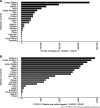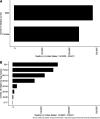Biobehavioral Aspects of the COVID-19 Pandemic: A Review
- PMID: 33790201
- PMCID: PMC8115744
- DOI: 10.1097/PSY.0000000000000932
Biobehavioral Aspects of the COVID-19 Pandemic: A Review
Abstract
Objective: This review highlights the scope and significance of the coronavirus disease 2019 (COVID-19) pandemic with a focus on biobehavioral aspects and critical avenues for research.
Methods: A narrative review of the published research literature was undertaken, highlighting major empirical findings emerging during the first and second waves of the COVID-19 pandemic.
Results: Interactions among biological, behavioral, and societal processes were prominent across all regions of the globe during the first year of the COVID-19 emergency. Affective, cognitive, behavioral, socioeconomic, and technological factors all played a significant role in the spread of infection, response precautions, and outcomes of mitigation efforts. Affective symptoms, suicidality, and cognitive dysfunction have been widely described consequences of the infection, the economic fallout, and the necessary public health mitigation measures themselves. The impact of COVID-19 may be especially serious for those living with severe mental illness and/or chronic medical diseases, given the confluence of several adverse factors in a manner that appears to have syndemic potential.
Conclusions: The COVID-19 pandemic has made clear that biological and behavioral factors interact with societal processes in the infectious disease context. Empirical research examining mechanistic pathways from infection and recovery to immunological, behavioral, and emotional outcomes is critical. Examination of how emotional and behavioral factors relate to the pandemic-both as causes and as effects-can provide valuable insights that can improve management of the current pandemic and future pandemics to come.
Copyright © 2021 The Author(s). Published by Wolters Kluwer Health, Inc. on behalf of the American Psychosomatic Society.
Figures





Comment in
-
Biopsychosocial Processes of Health and Disease During the COVID-19 Pandemic.Psychosom Med. 2021 May 1;83(4):304-308. doi: 10.1097/PSY.0000000000000954. Psychosom Med. 2021. PMID: 33938503
-
Equity, Environment, and the Biopsychosocial Ecology of the COVID-19 Syndemic.Psychosom Med. 2021 Nov-Dec 01;83(9):1089-1091. doi: 10.1097/PSY.0000000000001020. Psychosom Med. 2021. PMID: 34596057 No abstract available.
References
-
- World Health Organization . Coronavirus disease (COVID-19)—World Health Organization. WHO; 2020. Available at: https://www.who.int/emergencies/diseases/novel-coronavirus-2019. Accessed August 3, 2020.
-
- World Health Organization . Novel Coronavirus (2019-nCoV): Situation Report, 1. Geneva, Switzerland: World Health Organization; 2020. Available at: https://apps.who.int/iris/handle/10665/330760. Accessed January 19, 2021.
-
- World Health Organization . Coronavirus Disease 2019 (COVID-19): Situation Report, 72. Geneva, Switzerland: World Health Organization; 2020. Available at: https://apps.who.int/iris/handle/10665/331685. Accessed January 19, 2021.
Publication types
MeSH terms
LinkOut - more resources
Full Text Sources
Other Literature Sources
Medical

